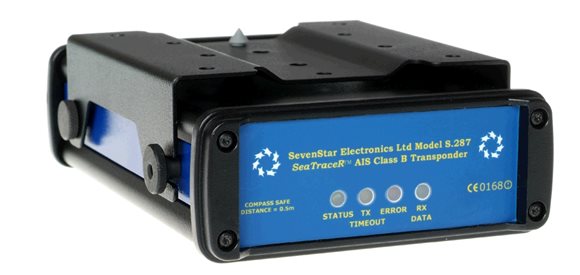SeaTraceR AIS SevenStar: AIS Transponder

AIS SeaTraceR SevenStar transponder, visibility; AIS system, PC configuration software, built-in GPS receiver, optional VHF/GPS antenna.
Description
Extremely reliable and solid transponders able to make the vessel visible in the AIS system and thus implement the safety level of any navigation.
It is equipped with special PC software that allows you to easily program the unit with your own data, but also monitor the operating status and the data received.
The built-in GPS receiver (16 channels + WAAS) allows you to streamline connection procedures and provide the system with your position precisely. It is also possible to connect an external switch (not supplied) to deactivate the position transmission at appropriate times.
The VHF and GPS antenna must be purchased separately.
Technical characteristics
Prices
030-1200
SevenStar SeaTraceR AIS Transponder Class B
976,00€Weight: 2 kg; Dimensions: 28 x 20.5 x 8 cm
Equipment
- Instruction manual
- RS232 serial interface cable
- Software CD
- Bracket and knobs
Accessories
031-1110
SevenStar SX.588 AIS/GPS Combo Antenna
248,00€031-1210
SevenStar Splitter antenna for AIS transponder
443,00€
Series
AIS Automatic Identification System
It is a collision avoidance and coordination system for maritime traffic that allows you to monitor the position and other relevant information of vessels equipped with AIS transponders (transmitters).
Normally chartplotters have the ability to process this data and therefore are able to represent on the chart the position of these vessels, along with other relevant information such as course, speed, name, MMSI, type, size and many more.
The frequency used is VHF and therefore the range is normally between 10 and 30 miles.
AIS
models There are currently two classes in use: class "A" is reserved for ships (mandatory for gross tonnage > 300t.), while class "B" was created for all other uses (pleasure) and is more limited in the power output, in the number of information (however abundant) and in the frequency with which they are transmitted.
There are also models limited to reception only (passive AIS) that can therefore receive information from other vessels, but cannot transmit their own to the system. They cannot therefore inform others of their position and therefore the level of safety offered is much more limited: no one would drive with the lights off believing that the lights of the other vehicles are sufficient.
For these reasons the transponder (or AIS active or unit capable of receiving and transmitting) class "B" is the unit recommended for recreational use.
Information from Class "B"
? MMSI?
SoG (Speed Over Ground)
? Position
Error ? Latitude and Longitude?
CoG (Course Over Ground)
? Course Vera
? Date/Time of information
? Name of the vessel
? Type of boat
? Dimensions of the vessel
? Position in the vessel where the GPS is installed
? Type of differential receiver installed
AIS transponder, why
? It is not only an important tool to avoid collisions, but also makes itself useful in all emergency situations. For example, when we need to contact boats in the vicinity or allow rescuers to better locate their location. Let's not forget also that knowing the presence of other boats improves the perception of the situation, thus making the choices of the captain more aware.
Because of these peculiarities, AIS is becoming more widespread, especially for the following users:
? Sailing boats that sail at a distance
? Racing boats (in some regattas is required)
? In deep-sea
fishing? In coastal fishing (trolling, boiling, diving)
? For those who prefer the roadstead
? Who often sails near the ports
? To monitor friends
' boats ? For those who sail abroad (in some countries it is required)